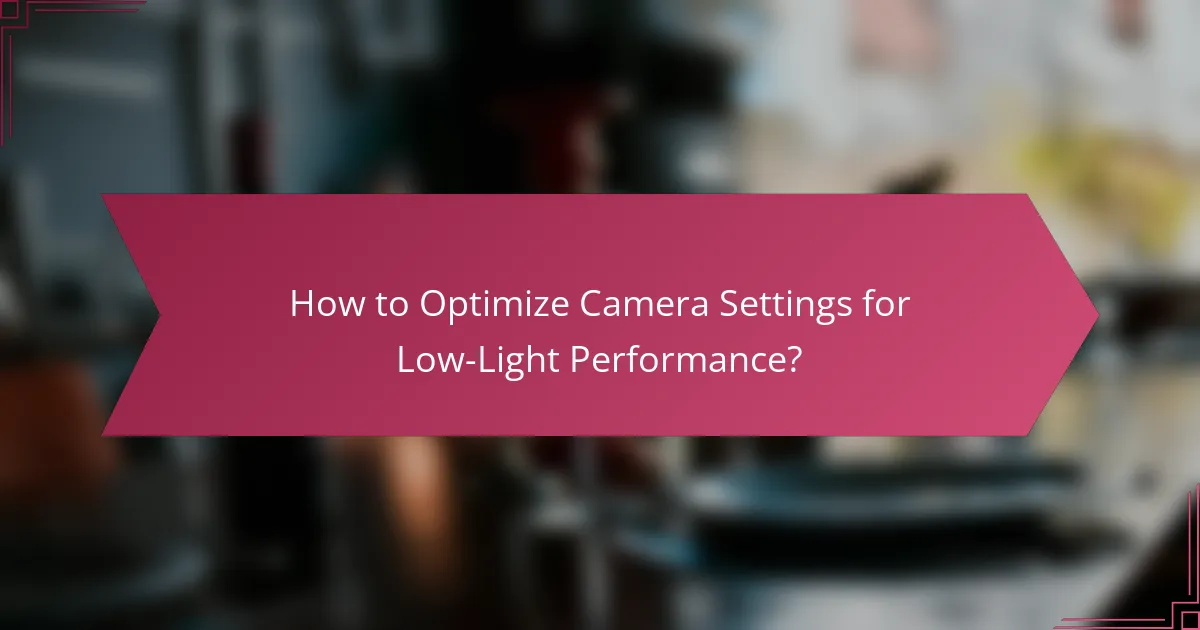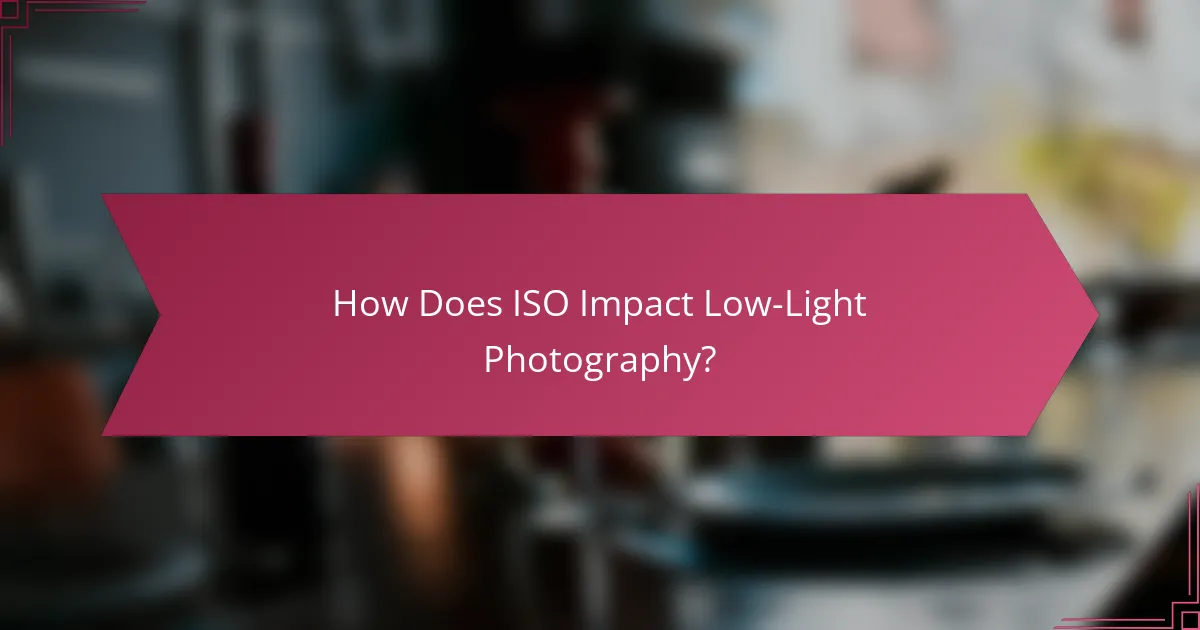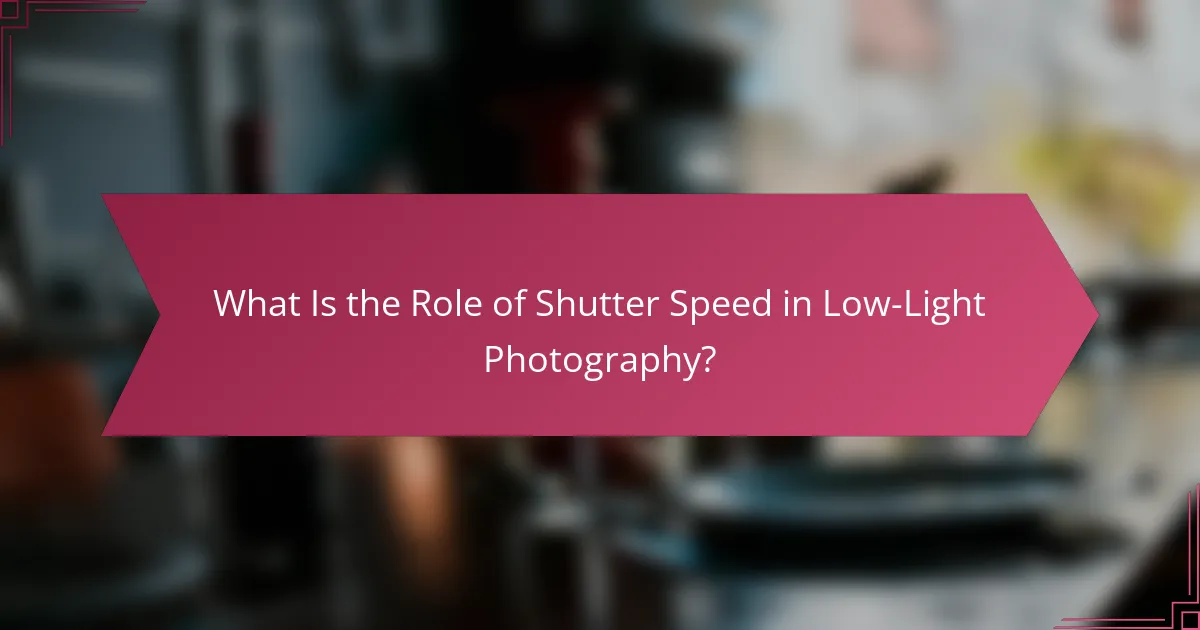Capturing stunning images in low-light conditions requires careful adjustment of your camera settings. By increasing the ISO, widening the aperture, and using slower shutter speeds, you can enhance your camera’s sensitivity to light and achieve clearer results. However, it’s essential to maintain stability to avoid noise and blur, ensuring that your low-light photography is both effective and visually appealing.

How to Optimize Camera Settings for Low-Light Performance?
To enhance low-light performance, adjust your camera settings to increase sensitivity and capture more light. Key adjustments include raising ISO, widening aperture, and using slower shutter speeds, while also ensuring stability to minimize noise and blur.
Increase ISO sensitivity
Raising the ISO sensitivity allows your camera to capture more light, making it easier to shoot in dim conditions. Typical ISO settings for low-light photography range from 800 to 3200, depending on your camera’s capabilities.
However, higher ISO values can introduce noise, which may degrade image quality. It’s essential to find a balance between light sensitivity and acceptable noise levels.
Use a wider aperture
A wider aperture (lower f-stop number) lets more light enter the camera, improving exposure in low-light situations. For instance, an aperture of f/1.8 allows significantly more light than f/4.0.
While using a wider aperture can enhance brightness, it also reduces depth of field, which may not be ideal for all subjects. Consider your composition and focus needs when adjusting aperture settings.
Utilize slower shutter speeds
Slower shutter speeds increase the time the sensor is exposed to light, which is beneficial in low-light environments. Speeds of 1/30 second or slower can be effective, but be cautious, as this can lead to motion blur if the camera or subject moves.
To mitigate blur, consider using a tripod or stabilizing your camera against a solid surface when using slower shutter speeds.
Stabilize the camera
Stabilizing your camera is crucial when shooting in low light, especially with slower shutter speeds. Using a tripod or a monopod can significantly reduce camera shake and improve image clarity.
If a tripod isn’t available, brace your camera against a wall or other stable surface to enhance stability. Additionally, using image stabilization features, if available, can help reduce blur caused by minor movements.
Employ noise reduction techniques
Noise reduction techniques can help improve image quality when shooting at high ISO settings. Many cameras have built-in noise reduction features that can be activated in the settings menu.
Post-processing software can also be used to reduce noise in images. Programs like Adobe Lightroom or Photoshop offer tools specifically designed to minimize noise while preserving detail, which is particularly useful for low-light shots.

What Exposure Settings Are Best for Low-Light Conditions?
For low-light conditions, the best exposure settings typically involve a combination of a wide aperture, a high ISO, and a slower shutter speed. These adjustments help capture more light, resulting in clearer images even in dim environments.
Manual exposure mode
Using manual exposure mode allows photographers to have complete control over aperture, ISO, and shutter speed settings. This is particularly useful in low-light situations where automatic settings may not yield optimal results. By manually adjusting these parameters, you can fine-tune your exposure to achieve the desired brightness and detail.
Start by setting a wide aperture (e.g., f/1.8 to f/4) to let in as much light as possible. Then, adjust the ISO to a higher value (e.g., 800 to 3200) to increase sensitivity to light. Finally, choose a shutter speed that balances motion blur and exposure, typically between 1/30 to 1/125 seconds.
Exposure compensation adjustments
Exposure compensation allows you to adjust the exposure level without switching to manual mode. This is particularly useful when shooting in low-light conditions where the camera’s metering might underexpose the image. By increasing the exposure compensation (e.g., +1 to +2 stops), you can ensure that your images are brighter and more detailed.
Keep in mind that overexposing can lead to loss of highlights, so use this feature judiciously. A good practice is to take a test shot and review the histogram to determine if further adjustments are needed.
Use histogram for exposure checks
The histogram is a valuable tool for assessing exposure in low-light photography. It visually represents the distribution of tones in your image, allowing you to see if the highlights or shadows are clipped. Aim for a balanced histogram that does not touch either end, indicating that you have captured a full range of tones.
When shooting in low light, check the histogram after each shot. If the graph is skewed to the left, your image may be underexposed; if it’s pushed to the right, you risk losing detail in the highlights. Adjust your settings accordingly to achieve a more balanced exposure.

How Does ISO Impact Low-Light Photography?
ISO plays a crucial role in low-light photography by determining the camera sensor’s sensitivity to light. A higher ISO setting allows for better performance in dim conditions, but it can also introduce unwanted noise into the images.
Higher ISO increases sensitivity
Increasing the ISO setting on your camera enhances its sensitivity to light, enabling you to capture images in darker environments without using a flash. For instance, while a standard ISO of 100 might be ideal for bright daylight, settings ranging from 800 to 3200 are often used for indoor or nighttime photography.
This increased sensitivity allows for faster shutter speeds, which can help reduce motion blur when capturing moving subjects in low light.
Trade-off with noise levels
While higher ISO settings improve low-light performance, they also raise the likelihood of noise in your images. Noise appears as grainy or speckled patterns, which can detract from image quality, especially in shadow areas.
Photographers often need to find a balance between achieving adequate exposure and maintaining acceptable noise levels. Generally, keeping ISO below 1600 is advisable for most consumer cameras to minimize noise, while professional models may handle higher settings better.
Recommended ISO ranges for various cameras
Different cameras have varying capabilities when it comes to ISO performance. For entry-level DSLRs and mirrorless cameras, an ISO range of 100 to 1600 is typically recommended for optimal quality. Mid-range models can often handle ISO settings up to 3200 with manageable noise levels.
Professional cameras, particularly full-frame models, can effectively operate at ISO levels of 6400 or even higher, allowing for exceptional low-light photography. Always test your specific camera to determine its limits and adjust accordingly based on your shooting conditions.

What Is the Role of Shutter Speed in Low-Light Photography?
Shutter speed is crucial in low-light photography as it determines how long the camera’s sensor is exposed to light. A longer shutter speed allows more light to hit the sensor, which is essential for capturing clear images in dim conditions.
Longer shutter speeds capture more light
Longer shutter speeds, typically ranging from several tenths of a second to multiple seconds, enable the camera to gather more light. This is particularly beneficial when shooting in low-light environments, such as during twilight or indoors. For instance, a shutter speed of 1 second can significantly brighten an image compared to a speed of 1/60 second.
However, it’s important to balance the exposure time with the scene’s lighting conditions to avoid overexposure. Using a tripod can help stabilize the camera during these extended exposures, ensuring sharper images.
Risk of motion blur
While longer shutter speeds enhance light capture, they also increase the risk of motion blur. Any movement from the camera or the subject can result in a blurry image, which is undesirable in most photography. For instance, a shutter speed of 1/4 second might capture more light but could also blur moving subjects.
To mitigate motion blur, consider using faster shutter speeds when photographing moving subjects or employing stabilization techniques. If you must use a longer exposure, ensure the subject is stationary and the camera is securely mounted.
Best shutter speed settings for low-light
The best shutter speed settings for low-light photography depend on the specific conditions and desired effects. Generally, a shutter speed of 1/60 second or slower is recommended for still subjects, while faster speeds may be necessary for moving subjects.
Experimenting with shutter speeds between 1/30 and 2 seconds can help you find the right balance for your scene. Always remember to adjust your ISO and aperture settings accordingly to maintain proper exposure without introducing noise or sacrificing depth of field.

How to Choose the Right Camera for Low-Light Photography?
Choosing the right camera for low-light photography involves considering sensor size, low-light performance ratings, and brand reputation. A camera with a larger sensor and better low-light capabilities will help you capture clearer images in dim conditions.
Sensor size and type considerations
The sensor size significantly impacts low-light performance. Larger sensors, such as full-frame sensors, typically gather more light, resulting in better image quality in low-light situations compared to smaller sensors like APS-C or Micro Four Thirds.
Additionally, the type of sensor matters. CMOS sensors are generally preferred for low-light photography due to their efficiency and ability to reduce noise at higher ISO settings. Understanding these factors can guide you in selecting a camera that excels in challenging lighting conditions.
Low-light performance ratings
Low-light performance ratings often reflect a camera’s ability to handle high ISO settings without introducing excessive noise. Look for cameras that perform well at ISO levels ranging from 1600 to 6400, as these are common thresholds for low-light photography.
Many reviews and tests, such as those from DxOMark, provide detailed insights into how different models perform in low-light scenarios. Pay attention to these ratings when evaluating potential cameras to ensure you choose one that meets your needs.
Brand comparisons: Canon vs Nikon vs Sony
When comparing brands for low-light photography, Canon, Nikon, and Sony each have strengths. Canon cameras often excel in color accuracy and skin tones, making them popular for portrait photography in low light.
Nikon is known for its robust low-light performance, particularly in its full-frame models, which can handle high ISO settings effectively. Sony, with its mirrorless technology, offers impressive low-light capabilities and fast autofocus, making it a strong contender for dynamic shooting environments.
Ultimately, the best choice depends on personal preference and specific photography needs, so consider testing models from each brand to find the right fit for your low-light photography style.
